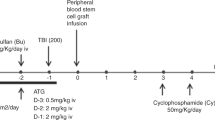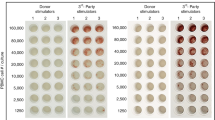Abstract
The prophylactic use of T cell depletion (TCD) strategies for the prevention of graft-versus-host disease (GVHD) following allogeneic stem cell transplantation remains widespread. Initial reports of high incidence of graft rejection after TCD BMT led to a move away from this approach but improved conditioning regimens have reduced this risk substantially. The use of TCD has also been associated with higher relapse risk post-BMT although the success of donor leukocyte infusion (DLI) as treatment for relapse has reduced this problem, especially in chronic myeloid leukaemia (CML). Currently the use of TCD BMT is increasing particularly due to the relative increase in BMT from non-related donors for whom TCD is the optimal GVHD prophylaxis. However, doubts remain over the long-term effect on the reconstituted immune system of recipients of TCD BMT, particularly in adult recipients. In this study we have undertaken a detailed sequential analysis in 23 patients who received allo-grafts from HLA-identical sibling donors after high-dose chemo/radiotherapy for acute or chronic leukaemia. Of these patients, 11 received non-manipulated grafts, five received ‘partially TCD’ (PTCD) and a further seven received ‘fully TCD’ (FTCD) bone marrow. T cell depletion was performed ex vivo by Campath-1M plus autologous serum as a source of complement. Partial TCD describes grafts with a T cell reduction of 1–2 log. Full TCD refers to grafts with a reduction of >2.5 log. The decision regarding the optimal degree of TCD was clinical and was based upon the perceived relative risk of relapse based upon the disease and remission status. All patients were monitored for up to 12 months post-BMT with regard to reconstitution of T and NK cell subsets. T cell depletion at either level was associated with a slower recovery of CD4 cells. This was most marked in the FTCD recipients and lasted throughout the period of study. CD8 cell recovery was also slower in the TCD recipients but this normalised throughout the 12 months post-BMT. The ratio of CD45RA+:CD45RO+ increased in all recipients after month 3. This suggests that a degree of extra-thymic T cell maturation can occur in recipients of allogeneic BMT. NK cell recovery was more rapid in the TCD recipients and these differences were maintained throughout the first year.
This is a preview of subscription content, access via your institution
Access options
Subscribe to this journal
Receive 12 print issues and online access
$259.00 per year
only $21.58 per issue
Buy this article
- Purchase on Springer Link
- Instant access to full article PDF
Prices may be subject to local taxes which are calculated during checkout
Similar content being viewed by others
Author information
Authors and Affiliations
Rights and permissions
About this article
Cite this article
Lowdell, M., Craston, R., Ray, N. et al. The effect of T cell depletion with Campath-1M on immune reconstitution after chemotherapy and allogeneic bone marrow transplant as treatment for leukaemia. Bone Marrow Transplant 21, 679–686 (1998). https://doi.org/10.1038/sj.bmt.1701153
Received:
Accepted:
Published:
Issue Date:
DOI: https://doi.org/10.1038/sj.bmt.1701153
Keywords
This article is cited by
-
Strategies to enhance the graft versus tumour effect after allogeneic haematopoietic stem cell transplantation
Bone Marrow Transplantation (2019)
-
Serotherapy with thymoglobulin and alemtuzumab differentially influences frequency and function of natural killer cells after allogeneic stem cell transplantation
Bone Marrow Transplantation (2008)
-
A novel reduced-intensity stem cell transplant regimen for nonmalignant disorders
Bone Marrow Transplantation (2005)
-
Effective donor lymphohematopoietic reconstitution after haploidentical CD34+-selected hematopoietic stem cell transplantation in children with refractory severe aplastic anemia
Bone Marrow Transplantation (2004)
-
Donor lymphocyte infusions in adult haploidentical transplant: a dose finding study
Bone Marrow Transplantation (2003)



